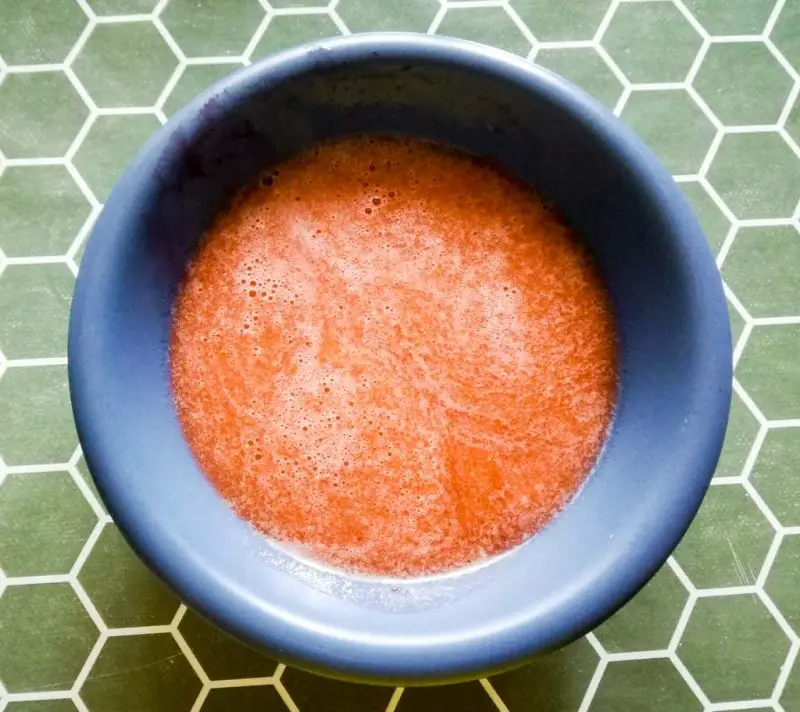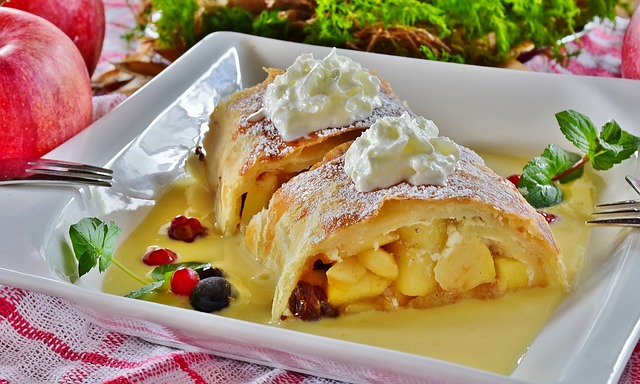Hungarian Cuisine and Food Facts
As a Hungarian, I can tell you, Hungarian cuisine is heavy, fatty and we eat a lot of meat and sweets. The fundamental parts of Hungarian meals are meat, sausages, paprika (the spice!), onion, dairies and thick vegetable stews. But don’t worry, if you are vegetarian, you will still have plenty of dishes to choose from, for example, the delicious vegetable stews. The food culture is really diverse.
Are you ready for an imaginary journey to experience the unique Hungarian cuisine and food? Let me show you what the most unique ingredients are.

Paprika
Paprika is the most popular ground spice in Hungary, made from dried peppers. You can find numerous different versions of it, from sweet to spicy.
Almost every non-sweet Hungarian dish contains it. Yes, we really like its taste.
Garlic and Onion
Other fundamental parts of the Hungarian cuisine. As the joke says, Hungarian recipes all start like chop an onion and braise it a bit of lard…
Túró – Quark
Sweet quark is a popular ingredient in several below-mentioned foods.
Kolbász – Sausage
Téliszalámi (Winter Salami) and other hard sausages are commonly consumed for dinner or being part of other recipes. Some of the most popular sausages are Gyulai and Csabai.
Soups – Levesek
Soups are commonly eaten before the main meal in Hungary.
Gulyásleves – Goulash Soup

Goulash (gulyásleves) is a traditional Hungarian food from the middle ages, typically cooked in a cauldron (bogrács), but you can prepare it in the kitchen as well. It is a vegetable and meat soup, seasoned with paprika.
Halászlé – Fisherman’s soup
Fish soup with paprika is one of the most famous Hungarian food. It is made with the locally available freshwater fish, usually from carp (ponty). It is often served as a Christmas dish too. It can be spicy as well and traditionally cooked in a cauldron. The most famous versions are Bajai and Szegedi. The first is a simpler and faster version, served with thin pasta.
Gyümölcsleves – Cold Fruit Soups

Cold fruit soups are very popular sweet dishes, especially during the hot summer days. They are made from seasonal fruits (redcurrants, blackberries, sour cherries, apple, pear, etc), one of the most popular ones is the cold sour cherry soup, but my personal favorite is a strawberry soup with rhubarb (see the pic). These fruits soups are suitable for vegetarians and for vegans.
Húsleves – Meat Soup
Húsleves is a meaty soup, traditionally made of beef or chicken with bones, but the version using veal is also popular. Usually, it is served with angel hair noodles (cérnatászta), grízgombóc (semolina dumplings) or májgombóc (chicken liver dumplings). Cooking time is 2 to 3 hours, and therefore typically eaten on Sundays.
Jókai-bableves – Jokai Bean Soup
A rich bean soup, with lots of veggies, smoked pork pieces, and noodles, served with sour cream on top. Some people add vinegar to it, but I personally don’t like that version. The soup is named after the famous Hungarian writer Mór Jókai by Károly Gundel the founder of one of the most well-known restaurants in Hungary in 1937.
Main Hungarian dishes
Csirkepaprikás – chicken paprikash
A chicken stew with lots of (sweet or hot) paprika and sour cream, served usually with dumplings. Known as chicken paprikash in many Central and Eastern European countries, and typical Hungarian food.
Rántott hús – Wiener schnitzel
I know, this is an Austrian dish originally, but it is served regularly in every (non-vegetarian) Hungarian household. The meat is tenderized, then covered in flour, then eggs, and breadcrumbs last, after that it is fried.
Vadas – Venison
Vadas is cooked with venison, such as wild boar, deer, wild duck or hare, to a thick brown ragu with thin carrot slices. it is typically served with bread dumplings or boiled potatoes.
Hurka
Similar to black pudding, two main versions are véres (with blood) and májas ( with liver).
Rakott káposzta – Layered Cabbage Dish
A typical Hungarian cabbage dish from Transylvania. The layers consist of cabbage, meat stew, rice, sour cream, and spices.
Töltött paprika – stuffed peppers

A Balkan-wide known dish, stuffed peppers with pork mince and rice. It is served in a tomato sauce with soft boiled potatoes.
Hortobágyi palacsinta – Hortobagyi crepes
Palacsinta is a well-known dessert (see below), however, there a couple of dishes where it is served as a main dish. The not so thin pancakes are filled with meat stew (veal or chicken and onion), topped with sour cream then baked in the oven.
Lecsó (Ratatouille a la Hungarian)
A mixed vegetable stew made of tomato and paprika. It is a popular dish throughout the Balkans and some parts of Europe. The Hungarian version is without squash and zucchini, but you can add scrambled eggs to it.
Főzelék – Vegetable Stew

Thick vegetable stews can be made with a variety of vegetable bases, such as cabbage, potatoes, kidney beans, squash, spinach, lentils, tomatoes, sorrel, yellow or green peas. These are the dishes I really miss while living abroad!
For those who can’t imagine them without meat, often meatballs (fasírozott), spicy sausage (kolbász), or fried or boiled eggs (tükörtojás or főtt tojás) can be added.
Desserts
Palacsinta & Gundel Palacsinta – Crepes

Stuffed crepes. My personal favorites. I can eat them weekly as there are a variety of fillings. The most common ones are jam, sweet quark cheese (túró), cinnamon, poppy seed or even with meat (see at the main dishes section). The Gundel Crepes are filled with walnut and topped with delicious cocoa sauce.
Császármorzsa – Caesar’s crumbs
It is made from a very similar recipe as crepes but tastes and looks totally different. They can be described as shredded, sweet crepe pieces and are served with powdered sugar and/or jam on top. In Austria, it’s called Kaiserschmarrn and originated from the Austro-Hungarian Empire.
Kürtőskalács – Chimney Cake
The Chimney Cake is originated from Transylvania but you will find them not only in Hungary but all over Europe. The original version is covered only with sugar, but any flavor you can imagine is available.
Mákos Guba – Poppy Seed Flavored Dish from Pastry
Crescents and finely ground poppy seeds with sugar and milk baked in the oven. It is a popular Christmas food too.
Szilvásgombóc – Plum Dumplings
Sweet plum dumplings rolled in fried breadcrumbs. Their alternative shape is small noodles (called Nudli) without any fillings.
Derelye
Rhombus shapes sweet noodles topped with jams.
Gesztenyepüré – Chestnuts puree
Cooked and mashed sweet chestnuts topped with whipped cream. An easy to make and popular dessert as you can buy the puree in most shops.
Tejberízs – Rice pudding
Rice pudding topped with sweets.
Tejbegríz – Semolina Cream

Semolina cream topped with sweets. I like to mix it with a spoon of cocoa powder or a couple of pieces of dark chocolate.
Dobos Torta – Dobos Cake
A sponge cake layered with delicious chocolate paste and glazed with caramel and nuts.
Vaníliás kifli – Vanillin Crescent

Tiny crescent-shaped biscuits made with walnuts and covered with vanillin sugar.
Piskóta
A light, sweet and delicate cookie. It can be crispy or soft.
Kuglóf
Another traditional Austro-Hungarian cake, baked in a distinctive circular Bundt mold.

Madártej – Bird’s Milk
A floating island dessert made of milk custard with egg white dumplings floating on top.
Rétes – Strudel

A type of layered pastry with a filling such as fruits (apples, cherries), poppy seed, quark, cabbage, etc.
Hungarian Drinks – Alcoholic beverages
Tokaji Wine – Tokaji Bor Tokaji Aszú

Tokaji wine and Aszu are popular sweet white dessert wines from the Tokaj region. The Aszu is very sweet (and expensive) as it is made from a tremendous amount of grapes.
Egri Bikavér – Bull’s Blood
Dry dry red wine from the Eger wine region.
Pálinka
Palinka means a range of fruit brandies, the most common and cheapest ones are made with plum and pear, but it can be made from almost any fruit. As our common saying says, what can be used to prepare jam can also be used to produce pálinka
Unicum – Liquor
Herbal liquor of Hungary.
Bread and pastries
Lángos
Langos is a fried bread dough, topped with salt, cheese, sour cream, garlic or a combination of these. Very popular beach snack but generally you can buy it across the city in summer.
Kifli
Crescent-shaped bread.
Pogácsa
Round pastry in a variety of flavors such as cheese, bacon, cabbage and more.
Bundás kenyér
A bread with a fur jacket from eggs.

Sajtos perec – Pretzel

Salty pretzel-shaped pasty.
Kakaós csiga – Cocoa Snail Pastry
It is a rolled pastry, traditionally with cocoa, but other flavors (walnut, poppy seed, chocolate, and vanilla pudding) are also available.
Hungarian Restaurants in Budapest
You have different options for Hungarian food in Budapest. As most locals don’t eat at these places, their price range is somewhat higher than usual. If you like to taste Hungarian food in Budapest, visit one (or more) of the following restaurants:
Aszú Restaurant $$$ – Sas utca 4., Budapest 1051 Hungary
Hungarikum Bisztro $$ – Steindl Imre utca 13., Budapest 1051, Hungary
Retek Bistro $$ – Merleg utca 10., Budapest 1051, Hungary
The last one is a food court type of restaurant, where you pick your food from the counter then pay and proceed to one of the free tables.
Főzelékfaló Ételbár $ – Nagymező u. 18, 1065 Hungary
10 Unique & Secret Places in Budapest – Off the Beaten Track
3 Days in Budapest – Itinerary for First-Time Visitors with Kids

